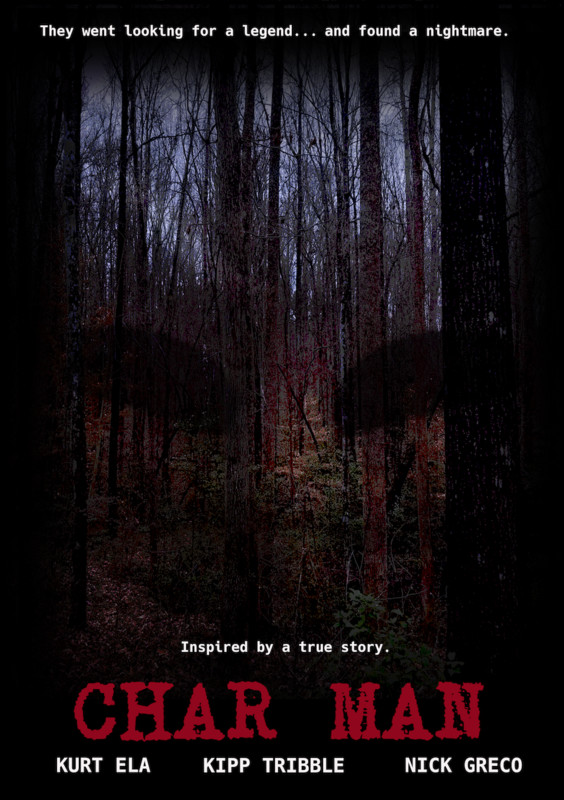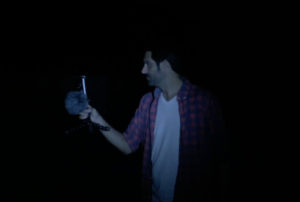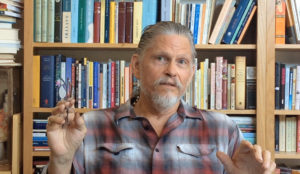Making CHAR MAN – a Horror Film Shot on Smartphones
My First Experience with Mobile Filmmaking
by Kipp Tribble

Char Man is a found footage horror film, with release dates to be announced in the near future.
This was my first feature shot with mobile devices. What started out as an experiment, turned out to be a fantastic – and eye opening – journey.
A Little Background
Let me start off by saying that I am not a cinematographer. Nor do I ever intend to be one. I also do not have the technical training of a cinematographer. I am, however, an actor and filmmaker. I’ve been writing, directing, producing and performing in feature films since 1996. With that experience, I have developed a deep knowledge and understanding of camera movement, framing, composition, consistency in style. So, I know how to approach capturing a narrative on camera.
Like many others, I have been closely following the evolution / revolution of mobile filmmaking. I was impressed with Tangerine and short films such as Love in New York. But I was also equally irritated by all the naysayers. You know, filmmakers that only point out what smartphones and tablets cannot do. Listing all of their shortcomings and insist that only “real movies” are shot on “real cameras”.
Then I heard that Soderbergh was shooting a feature with an iPhone – one of our greatest living filmmakers. I carefully began tracking the story of Unsane and how this might affect my own filmmaking in the future…
Time for Something Different
Near the end of 2017, I was coming off of a pretty busy couple of years making features with various cameras (aka, the “traditional” way). These films had varied budgets, crew sizes, casts, and so on. The most recent of the bunch – Coffin 2 – was at the peak of its successful run at Redbox across the U.S. and getting ready to hit multiple VOD platforms worldwide.
Given that success, the deal was already in the works to make Coffin 3. But I also knew production on that film would be a few months away, at best. I had several other possible projects to tackle but had been knocking around some ideas with a friend of mine, Kurt Ela, for some time. Kurt and I go way back, but we had never really jumped head first into a project together. The timing seemed right.
We both had also been experimenting and shooting test footage on our respective smart phones and tablets, so we decided that this project would be the perfect one to take the “mobile plunge”.
 The Idea
The Idea
We both wanted to do something fairly small in scale. We also wanted to produce this horror film at a fairly accelerated pace than most features are produced. This would all be part of the experiment. The cast would be very small and would of course feature the two of us. Additionally, we had both expressed interest in trying our hand at the improvisation method of feature filmmaking, working just from an outline much the same way the Duplass Brothers and others have done.
We both love comedy, but we also know the hurdles of selling a small-scale indie comedy with minimal cast. So, it was pretty easy to settle on a horror film, extensively outlined and heavily improvised.
Pre-Production and Technical Decisions
The decision was made pretty early on to have our “A” camera be an iPad. Our smartphones would be the “B” cameras. We also wanted our camera guy to actually be part of our cast. As opposed to a cast member being off camera pretending to film, while an actual operator ran camera. This led us to cast Nick Greco, an actor who is also a writer and producer and knows the ins and outs of physical production. With Nick operating the iPad, this would allow Kurt and I to be in the scenes. We could shoot supplemental footage as needed, within some of the scenes. In addition, we put Nick on camera when the moment called for it.
Due to the found footage elements, we also did not worry about making each shot beautiful. This was part of the plan from the beginning: to make the horror film fast, effectively, and not get bogged down by the constraints of making each shot ‘pretty’. In fact, to help hammer this home, we made our wannabe documentarian characters unorganized and ill prepared for the task of making a film. Additionally, Kurt and I both love the graininess that night shots in found footage films usually have. It adds to the creep factor, so we didn’t run away from that, we embraced it.
Sound, Light and Stabilizing
Other decisions we made were to both ‘fit’ the “found footage” mold, as well as to assist us in our fast-paced experiment.
I was used to having sound people, gaffers, grips, a DP, and multiple others on the team – people we had chosen NOT to have this time around. So, we needed a reason the process would be rough-around-the-edges. At the same time, we needed to capture clean sound and clean images since that is kind of a requirement for distribution companies!
We didn’t want to bring another crew member to run sound and we didn’t want to slow down with mics, so we outfitted the iPad with a Rode mic. In general, this did a fairly decent job, since much of our dialogue was near the camera.
Our smartphones did not get mics, because they were only supplemental, for the most part. We still wanted an ‘unproduced’ feel to the found footage. In fact, we use the difference in sound levels and quality to distinguish between cameras. We knew our sound would be on the rougher side – but that is what found footage is. And we again used that as part of our atmosphere, capturing life in a raw, unprocessed way.
Lighting
 For our horror film, we took a similar approach with lighting. Everything was available light, with one exception: flashlights. The majority of our night exterior scenes incorporated flashlights. The small LED lights not only provide bright, focused light, they also make the darkness around it grainier, and therefore, even darker. Which was exactly what we were going for. All other times, we went with whatever light was there.
For our horror film, we took a similar approach with lighting. Everything was available light, with one exception: flashlights. The majority of our night exterior scenes incorporated flashlights. The small LED lights not only provide bright, focused light, they also make the darkness around it grainier, and therefore, even darker. Which was exactly what we were going for. All other times, we went with whatever light was there.
The last piece of equipment we debated using, was a gimbal, which we eventually decided against. We didn’t mind the shakiness of the found footage style, but we also didn’t want to bog down our A camera too much, so we went with a simple handheld rig for Nick to operate the iPad. Some of the shakier footage did get stabilized in post, and we used it as a storytelling technique: as the film progresses and the things around the group begin to unravel, the footage becomes shakier and less stable. It’s a nice, subtle effect.
Apps and Resolution
We did several tests with apps and the devices’ native settings before making decisions on what to use. The iPad footage was captured using Filmic Pro (24fps) and Nick was able to play with the exposure and other settings on-the-fly, oftentimes mid-scene. Kurt’s smartphone (iPhone 6s) also employed Filmic Pro, and I used the Open Camera app for my Galaxy s8. All footage was 1080p, although I did accidentally grab a few shots in 4k because I had tested some footage and neglected to change it back to 1080p before a take. Of course, I noticed as soon as I started running into a space issue…
A bit about 4k. While it’s great to have your project in 4k, the overwhelming majority of delivery requirements are in 1080p. Yes, it can be nice to future proof your project a bit, as eventually everything will be in 4k, but we made the decision that this project would live in 1080p to make our lives slightly easier during production and in post.
Advantages
Char Man is an 85 minute feature film that we shot in 2 ½ days. We had over seven hours of footage and our longest shoot day was only about four hours long. Just like Soderbergh has said, shooting with a mobile device gives you the freedom for unprecedented fast-paced filmmaking. Point and shoot.
Now had we been focused on a superior image of a more traditional film (i.e., not found footage), we would have spent more time with ISO, shutter speed, white balance… all of the above. But even with those elements, we STILL would have been moving incredibly fast. And even had we decided to light some of the scenes, such as night interiors, we would STILL have been flying. And had we decided to do more than two takes – or different versions of improv in this case – we STILL would have been shooting 1/3 of a feature film every shoot day.
Point and shoot. This is what we were looking for. Could we have done this with a DSLR? Or other cameras? Absolutely, but in the spirit of our experiment, it didn’t make sense to go that route for Char Man. Plus, by using the iPad as our main camera, we then had two additional cameras that supplemented many of our scenes and were heavily used the last 15 minutes of the film. Lugging three other cameras around for the shoot just didn’t compute.
Flexibility
Another major advantage was camera placement. Even with compact cameras, often times they are ‘built out’ in some fashion. Be it lens, housing, whatever, the compact camera is suddenly not as compact as one would like. While we did not have any trick shots, like from the bottom of a punch bowl or something, we could easily place our cameras in very tight spots with only seconds of set up time. All the while being able to check the monitors without worrying about plugging them in, placing them, etc.
Obviously, the compact nature of the cameras led to an inconspicuousness that came in handy for our scenes in town. We were able to move relatively unnoticed through crowds, businesses, public parks and other locations. As well, larger cameras or equipment would usually slow us down due to inquisitive bystanders.
Disadvantages
Honestly, it’s hard for me to find a downside to using smartphones and tablets – on a found footage film, at least. I have been asked if I would do it again, and I already have. I am currently finishing up my second mobile film, Lobo, shot completely with an Android. But more on that another day…
Now, if we were making a traditional narrative feature, there are some disadvantages. But to me, none of them are deal breakers when making a low budget indie film.
Many of the disadvantages are the obvious culprits. The lenses are not up to par with professional camera lenses. Low light situations are tough for mobile devices. Punching in on footage in post does start to fall apart quicker than most other professional camera footage. You have to combat the variable versus constant frame rate issue. But again, these are not insurmountable odds. Not by a long shot.
So, get to it. Go make your film!
Eager to learn more?
Join our weekly newsletter featuring inspiring stories, no-budget filmmaking tips and comprehensive equipment reviews to help you turn your film projects into reality!


 The Idea
The Idea
A very inspiring read. The fact that they created the whole film is less than 3 days is amazing! I’ll need to check this out.